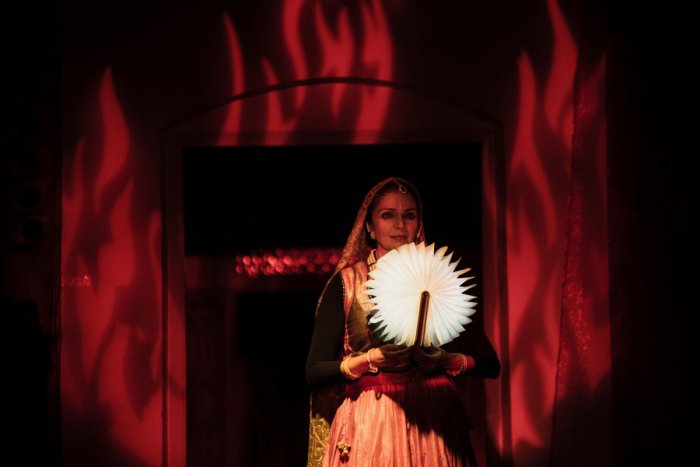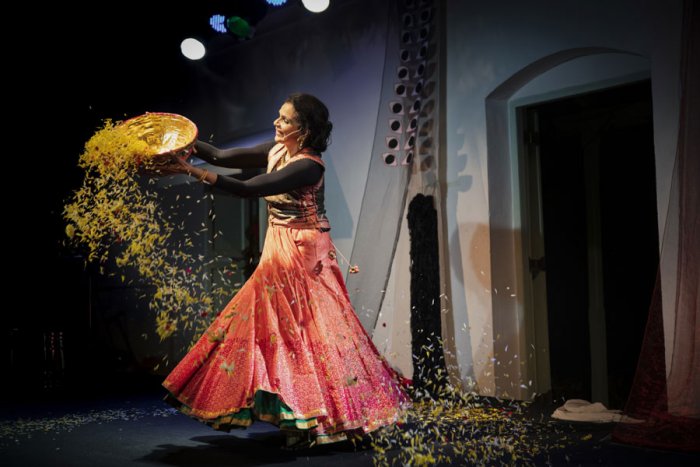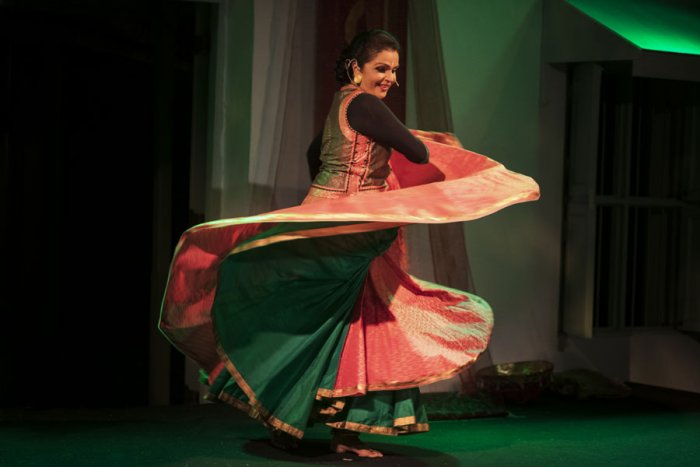
|   |

|   |
"Paavom, Bechari Sita" - Even in an opulent silk showroom... - Saranya Devan e-mail: saranya.devan29@gmail.com Photos: Raghuram Vedant March 2, 2020 The principal female characters woven into the story of the Ramayana have lent their names and characters to the range of exclusive silks at Kanakavalli, the temple of hand-crafted sarees. And full credit must go to dance activist, choreographer and teller of stories with a purpose, Anita Ratnam, for collections of sarees taking on names of the women protagonists in the mythology's blockbuster. Feisty and spirited Ratnam chose to break with tradition and recently performed her magnum opus, 'A Million Sitas', with the saree emporium as the theatre. I can already see in my mind's eye six yards of the finest silks flying off the shelves with style-names such as Manthara, the powerful plotter who schemed Lord Rama's exile; Mandodari, the pious and beautiful queen consort of Ravana; Ahalya, the victim whose innocence is proclaimed by Lord Rama; Surpanaka, the demon or damsel, depending on your perspective; and of course, Sita, the esteemed paragon of spousal and feminine virtues. By the way, the founder and curator of Kanakavalli, the silk sanctum-sanctorum, is Ahalya S. How's that for coincidence? February, the month of love, commenced with Ratnam choosing to serenade invited special guests to an exclusive rendition of her highly acclaimed one-woman dance drama, 'A Million Sitas,' against the backdrop of trees in the Kanakavalli property, which changed hues with spotlights, to keep with the mood of the narrative whilst resembling the Dandaka Forest. And did Ratnam succeed in getting the theme of her tale across? If you headed for the exit gate filled with pity and sadness for the plight of women of yesteryear, and even today, just like the persecuted Sita suffered and endured in Valmiki's epic, then Ratnam deeply drove her message home loud and clear: love has the power to make or break.   Counting myself blessed to land an invitation to 'A Million Sitas' at Kanakavalli's flagship store at Kingsley, located in the heart of Chennai, I entered the lovingly restored century-old family home built in the colonial style, with high ceilings, ornate columns and sprawling verandahs, through a cavernous white-walled hallway with ornate wooden doors. Guests were later treated to snacks, piping hot coffee and drinks in the lush, sprawling garden. Being a live artist myself, this set was to die for. Ratnam's dramatic centre-stage entrance in flowing robes added to the allure. Her powerful opening monologue on the character of Sita set the scene: "One name, four letters, two syllables: Sita. This is the story of Sita, a daughter, a friend, a princess, a wife and a mother," Then followed the stirring, soulful singing by Sharanya Krishnan with her rendition of Janaki Ramana set in raga Kapi. Krishnan was brilliant in her vocal backing with other moodful pieces- a Meera bhajan 'Paayoji', a verse from the Kamba Ramayanam in raga Desh and Kaana vendum set in raga Surati with superb percussion accompaniment by N.K. Kesavan. The audience was spellbound for the next 90 minutes. As we were treated to vignettes of the trials and tribulations faced by Sita, Ratnam's Bharatanatyam trained agility was put to good use - her subtle hand gestures and abhinaya were also on point. Ratnam cleverly infused small doses of humour into her story - she told how Sita was born out of a mighty sneeze which she expounded with sollukattus (thatta thom). Having watched 'A Million Sitas' 18 months ago in my home city, Durban, in South Africa, Ratnam has skilfully managed to keep the story fresh and alive through the clever introduction of different props that she has picked up along her travels to different countries. My personal favourite in the performance has got to be Ratnam's dance rendition as a frog depicting Ravana's wife, Mandodari. For this she works her hands in silky emerald green gloves. To add even greater "froginess" to the imagery, use was made of green gel lighting on a mango tree with strings of marigold hanging. The sollukattus rendered by Subhashri Ravi, in perfect tune and timing with the beat of the mridangam, brought alive the scene. The set designed by South African, Reshma Chhiba, worked brilliantly in this setting. It was clear to the audience that Ratnam has indeed practised greatly to make use of space to the fullest. We see her gliding effortlessly between hanging textile drapes made of ash, hessian and shwe-shwe (a South African print) which denote different geographical areas (Ravana's kingdom in Sri Lanka, the Dandaka Forest and Rama's kingdom in Ayodhya). Most of us are familiar with the popular marriage song "Seetha Kalyana...." Ratnam chose to use this Thyagaraja kriti in raga Shankarabharanam to good effect as a musical backdrop to the work, infusing it for different contexts. There is the scene of Sita's marriage to her Lord Rama when the couple circumvent the ceremonial fire and then play on the romantic swing. There is also a touching scene when Sita relates how her mother would sing "Seetha Kalyana..." whilst giving her an oil bath and wishing her a loving husband and happy marriage. This was not the case in reality - her marriage was punctuated with a life of embarrassment and mistreatment by her lover.   Ratnam often does the play in English. She read the audience well and since they were mostly from Chennai, the heart of Tamilnadu, she related much of the story in Tamil. Ratnam played the part of Ahalya to perfection - first as a pure, unblemished character and then as a tainted woman who fell prey to the lustful gods who set their eyes on her, causing her life and emotions to be frozen in time. I have no doubt that more than all else, it was Ahalya's plight that has fuelled Ratnam's passionate drive against the ill-treatment of women, giving impetus to the #Metoo movement in November 2018. This personal account will be incomplete if mention is not made of Ratnam's symbolic portrayal of Sita's dreams of a long, happy married life with Rama transforming into a nightmare. We see Sita spreading flower petals in an act of joy when she is rescued - only to walk all over it as her dreams are crushed. In all corners of the globe, millions of Sitas are trampled upon daily and have their self-confidence and spirit trampled upon by the ego of selfish men. We need more Anita Ratnams to free our Sitas from perpetual bondage. Born and raised in Durban South Africa, contemporary and Bharatanatyam dancer, dance enthusiast, choreographer, researcher and theatre maker. Devan is a Drama and Performance Studies graduate from the University of Kwa-Zulu Natal and is presently enrolled for a Masters in Dance at the University of Cape Town and Master of Bharatanatyam at University of Madras. |